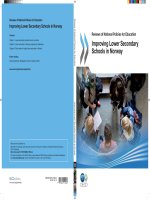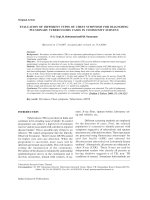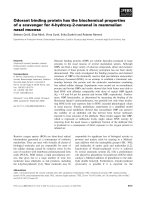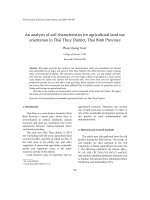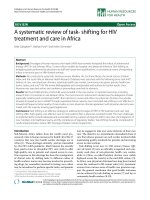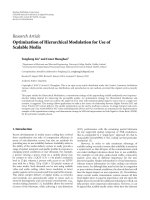Optimization of nitrogen content for improved Cry1Ac expression level in Bt cotton
Bạn đang xem bản rút gọn của tài liệu. Xem và tải ngay bản đầy đủ của tài liệu tại đây (171.47 KB, 6 trang )
Int.J.Curr.Microbiol.App.Sci (2019) 8(5): 851-856
International Journal of Current Microbiology and Applied Sciences
ISSN: 2319-7706 Volume 8 Number 05 (2019)
Journal homepage:
Original Research Article
/>
Optimization of Nitrogen Content for Improved
Cry1Ac Expression Level in Bt Cotton
R. Peardon1, M. Devasahayam2, A. Maxton1 and S.A. Masih1*
1
Molecular and Cellular Engineering, Sam Higginbottom University of Agriculture,
Technology and Sciences, Prayagraj, India-211007
2
Centre for Transgenic Technology, Sam Higginbottom University of Agriculture, Technology
and Sciences, Prayagraj, India-211007
*Corresponding author
ABSTRACT
Keywords
Bt cotton (BollgardII), Nitrogen, nBt
cotton, Cry1Ac
expression
Article Info
Accepted:
10 April 2019
Available Online:
10 May 2019
Bacillus thuringiensis is produced crystalline proteins, these proteins were used in
transgenic cotton to control insect pest. During present study, two trials were with 09
treatments plots of Bt cotton plants viz., 7, 14 and 21gm/m.sq. (T1, T2 amd T3) of
nitrogen with one row combination of nBt cotton plants while T4, T5, T6 were having two
rows combination of nBt cotton plants with same nitrogen treatment as in above mentioned
plots whereas T7, T8 and T9 were only treatment with different concentration of nitrogen
and there was no rows of nBt cotton plants around the plots were conducted. During this,
Cry1Ac protein expression level was analyzed. The results were compared in two ways,
one between the plots having same nBt rows but with different nitrogen concentration in
the soil and another among overall plots. The expression level was high on initial days
(30th day) that decrease gradually. Overall, T6 treatment showed highest Cry1ac
expression i.e., 6.443(µg/gm) whereas lowest reported expression was in plot T7. These
results show that the nitrogen content and different rows combination of the nBt expressed
a prominent effect over the expression of Cry 1 Ac protein.
most affected for agriculture crop loss due to
high occurrence of pests. In India, estimated
yearly agriculture production losses because
of pests are as high as US$ 42.66 million.
Whereas chemical pesticides are well known
for their success rate, but their effect on soil
and environment, footprints of residue in food
products are subject of concern (Subhash et
al., 2017). To overcome this problem mother
nature has shown a way to treat our crops
with toxins which are already present in our
ecosystem, which is Cry protein. Extracted
Introduction
Pesticides are the main cause of loss to the
farmers, every year hectares of crop get
spoiled due to pesticides. To reduce that
heavy loss implementation of chemicals as
pesticides to control pest is usual in
agriculture. There are many pesticides
reported which are of both chemical and
biological nature used in most of the countries
to reduce crop losses. This issue is prominent
in developing countries there farmers are
851
Int.J.Curr.Microbiol.App.Sci (2019) 8(5): 851-856
Cry toxin proteins from the bacterium
Bacillus thuringiensis (Bt) are used in sprays
or produced by transgenic crops for pest
control which is environmentally friendly and
non hazardous for humans. The enormous
varieties of Cry proteins present shared
structural three-domain group, which has a
similar mode of action. The Cry1Ac toxin is
one of the most active Bt toxins against the
larvae of Lepidoptera.
of Bt encoding insecticidal proteins that
provide protection from lepidopteran pests
(Amarjeet et al., 2016). After the introduction
of Bt cotton in India, the cotton production in
terms of area has shown a increase from 7.7
million hectares to 12.25 million hectares and
cotton fiber production has significantly
increased from 13.6 million bales to 39.1
million bales, whereas pesticides usage to
control lepidopteran pests has gone down
from 5,748 metric tons to 222 metric tons.
Various studies have concluded that Bt cotton
has increased farmer’s financial earnings
including those of smallholder farmers,
reduced pesticide usage and even improved
natural biocontrol (Chaudhary and Gaur,
2015).
The steps involved in the mode of action of
Cry1Ac and other three-domain Bt toxins
have been rigorously studied (Dohare and
Tank, 2014). After ingestion, the Cry1Ac
toxin is processed in the midgut fluids to an
active core that identifies binding sites in
proteins in the midgut brush border
epithelium. This binding is conducive to
further processing of the toxin and formation
of an oligomer, which inserts in the
membrane of midgut cells to form a pore
through the insertion of amphipathic alpha
helices in domain I. The toxin pore leads to
osmotic cell death, collapsing of the midgut
epithelial barrier, and invasion by resident
midgut bacteria of the hemocoel to cause
septicemia and the death of the insect
(Mushtaq et al., 2018).
Monsanto a leading name in the agriculture
industry came up with the different varieties
of genetically modified cotton crop. These
varieties carry different cry genes or its
combination. Bollgard® is a trademark for the
transgenic cotton varieties developed and
introduced by Monsanto. Bollgard® cotton is
genetically modified to resist lepidopterous
insect pests, has had a dramatic effect on
cotton production. The main objective behind
product concept was clear. Bt bacteria which
is found in soil, was well known for
producing a effective, specific and safe
protein insecticide.
Cotton (Gossypium hirsutum) is a chief fiber
crop which is grown largely in many parts of
the globe. Instead of only giving
exceptionally valuable fiber, cotton seed are
utilized as a source of edible oil and seed
cake, which is used as animal feed. In 2014,
~37 million hectares of land was sown with
cotton worldwide, mostly under rain fed and
dryland conditions. In India alone, the crop
was grown in ~12.25 million hectares of land
(James, 2014). Cotton is highly vulnerable to
broad varieties of lepidopteran pests, and a
leading one on the Indian subcontinent is
Helicoverpa armigera. A milestone in cotton
breeding was the development of transgenic
varieties and hybrids containing the cry genes
This protein was well characterized,
considered safe, and specific to the
lepidopterous class of insects. By introducing
the Cry gene synthesizing the Cry protein of
Bt into plants genome, so that these plants
would produce their own insecticide. This
simple concept promised to reduce insecticide
applications, improve insect control, and
provide
opportunities
for
aggressive
integrated pest management systems while
maintaining the inherent safety of this
insecticidal protein (Perlak et al., 2001).
852
Int.J.Curr.Microbiol.App.Sci (2019) 8(5): 851-856
treated with 7, 14 and 21gm/m.sq. of nitrogen
with one row combination of nBt cotton
plants while T4,T5,T6 were having two rows
combination of nBt cotton plants with same
nitrogen treatment as in above mentioned
plots. Whereas T7,T8 and T9 were only
treatment with different concentration of
nitrogen and there was no rows of nBt cotton
plants around the plots.
Materials and Methods
In this study two trials were conducted with
total 9 treatments plots of Bt cotton plants on
the basis of different row patterns that is one
row of nBt, two row of nBt and no rows of
nBt around the plots. Along with introducing
different concentration of nitrogen, which is
7gm/m.sq., 14gm/m.sq. and 21gm/m.sq in
each plots (Gangaiah et al., 2013). Field trials
of Bt cotton BollgardII (KCH14K59) Jadoo
variety (commercial name) was done and the
upper leaf from the Bt cotton plant is obtained
for the ELISA analysis. The sample is
collected in a random manner from each plot
in duplicate. These samples were collected
and analyzed for the quantification of cry1 Ac
protein in different time intervals of 30, 45,
60, 90, 120 and 150 days after sowing.
Comparison of means for Cry1 Ac in one
rows of nBt crops in BG-II field trials with
treatment of different nitrogen content in
the soil among respective plots
The mean results of first trial and second trial
(Fig.1 and Fig.2) was calculated by using the
WASP tool which is available on ICAR Goa
website. The plots T1, T2 and T3 which
shared one rows of nBt between the plots,
shows on the 30th day ELISA analysis for
Cry1Ac protein expression, that the highest
cry1 Ac expression in the upper leaves of Bt
cotton plant was in plot T3.Which was treated
with 21gm/m.sq of nitrogen the mean of T3 is
6.023(µg/gm) and 6.066 (µg/gm) in
respective trials 90 (Gangaiah et al., 2013).
The Quantification of Cry1AC protein was
done by Bt-Quant Kit acquired from Central
Institute for Cotton Research.
For protein quantification the two punches
from each cotton leaf was taken and crushed
in a 02ml eppendorf tube along with 500ul of
extraction buffer. After the crushing of a leaf
disc, centrifuged it at 10,000rpm for 5
minutes at room temperature. Mean time 50ul
of enzyme conjugate was added in a 96well
microtitter plate which is embedded by the
specific antibody of cry protein. Add 50ul of
centrifuged sample in each well and Keep it
for one hour incubation. Later give washing
by pipetting out the sample and enzyme
conjugate with washing buffer. Once the
washing is done add 100ul of substrate in to
the wells and wait for 20 minutes, then add
50ul of the stop solution to stop the reaction
in the wells. The reading was taken at 450nm.
Least expression was reported in Bt cotton
plant leaves of plot T1 which has the mean
value of 5.946(µg/gm) and 5.866(µg/gm) and
got treated with 7gm. Whereas the expression
mean of plot T2 which was treated with
14gm/m.sq. of nitrogen is higher than T1 but
lower than T3 with the mean value of
6.013(µg/gm) and 5.946(µg/gm). In the other
days of analysis which were 45th, 60th, 90th,
120th and 150th.
The expression of cry1Ac protein was
gradually decreasing in all the above
mentioned plots (Kranthi et al., 2005). At the
150th day the mean of plots T1 is
0.296(µg/gm)
and
0.313(µg/gm),
T2
0.334(µg/gm) and 0.352 and T3 0.384(µg/gm)
and 0.382(µg/gm) (Gangaiah et al., 2013).
Results and Discussion
There were total 9 treatments plots of Bt
cotton plants from which T1,T2,T3 were
853
Int.J.Curr.Microbiol.App.Sci (2019) 8(5): 851-856
The results show the expression difference by
varying nitrogen concentration in the soil,
because the plot which was rich in nitrogen
concentration gave the highest protein
expression level in its plants.
Comparison of means for Cry1Ac in plots
without any rows of nBt crops in BG-II
field trials with treatment of different
nitrogen composition among respective
plots
Comparison of means for Cry1Ac in two
rows of nBt crops in BG-II field trials with
treatment of different nitrogen composition
among respective plots
This set of treatments which were without any
rows of nBt between the plots treated with 7,
14 and 21gm/m.sq of nitrogen in the soil. The
30th day analysis of ELISA for analyzing the
cry1Ac protein expression in the T7,T8 and
T9 plots determines that the protein
expression was similarly high in the T9 plot
(21gm/m.sq N) as it was in other set of plots
discussed above. Leaves samples derived
from the Bt cotton plants of T9 plot gave the
higher expression mean 5.516(µg/gm) and
5.511(µg/gm) compared to other two plots
T7(7gm/m.sq. N) and T8(14gm/m.sq. N). The
mean values of T7 is 5.312(µg/gm) and
5.486(µg/gm) and T8 with mean values
5.346(µg/gm) and 5.543 (µg/gm) in both the
trials. Mean values of these plots at 150th day
analysis shows that the protein expression is
comparatively less than other days of
analysis. T7 0.223(µg/gm) and 0.243(µg/gm),
T8 0.308(µg/gm) and 0.267(µg/gm), T9
0.356(µg/gm) and 0.333(µg/gm) (Srikanth et
al., 2018). The comparison shows that the
plot which was high in nitrogen content
posses high cry1Ac expression which means
that nitrogen concentration do have a impact
on the protein expression.
The expression of cry1Ac for the plots T4, T5
and T6 which were treated with same 7gm,
14gm and 21gm of nitrogen per meter square
in the plot and having two rows of nBt
between the plots shows the prominent
results. Plot T4 which was treated with
7gm/m.sq. of nitrogen showed the minimum
expression mean in both the trials
5.816(µg/gm) and 6.306(µg/gm) when
compared to other two plots T5 and T6.
Cry1Ac expression in the Bt cotton plant
leaves is higher in plot T5 6.382(µg/gm) and
6.406(µg/gm), while comparing it with plot
T4.
Whereas plant leaves of plot T6 showed the
significantly high results for expression of
Cry1Ac protein with the mean of
6.511(µg/gm) and 6.443(µg/gm) (Dohare and
Tank, 2014) which is higher than other two
comparative plots with different nitrogen
content in the soil. Here also the expression
was decreasing by passing days after sowing
and on the analysis of the 150th day after
sowing the expression results were minimum
but in the similar pattern of expression in
different plots. T4 0.425(µg/gm) and
0.433(µg/gm),
T5
0.466(µg/gm)
and
0.453(µg/gm),
T6
0.473(µg/gm)
and
0.477(µg/gm) (Pomgothai et al., 2010). Due
to the varying nitrogen concentration in the
soil the result was high in the plot which was
high in nitrogen concentration compared to
other plots.
Comparison of means for Cry1Ac
expression among all the treated plots
While comparing the Cry1Ac expression
among all the plots as seen in the graphical
representation of both the trials (fig:1and2)
was highest in the Treatment T6 which was
6.511 and 6.443 (µg/gm) in respective field
trials at 30 days after sowing. This plot was
treated with 21gm/m.sq. of nitrogen. Which
clearly shows a significant difference in
expression of cry1 Ac protein while compared
854
Int.J.Curr.Microbiol.App.Sci (2019) 8(5): 851-856
On the 150th day the mean value of the
cry1Ac expression of these highest and lowest
plots were also showed significant difference.
T6 0.473(µg/gm) and 0.477(µg/gm) and T7
with the mean values 0.223(µg/gm) and
0.243(µg/gm) (Manjunatha et al., 2015). Due
to the different rows combination and
nitrogen concentration the cry1Ac expression
was higher in the plot which was having more
number of nBt rows and high in nitrogen
concentration in its soil.
to other treatments which were having
different rows combination of nBt and
nitrogen content on the plot. Though the
expression of the cry protein was found to be
gradually decreasing in 45, 60, 90, 120 and
150 days after sowing. The lowest reported
expression was found on the plot T7 which
was not treated with any rows combination of
nBt only having least treatment concentration
of nitrogen which was 7gm/m.sq. the
expression of cry protein on 30th day after
sowing was 5.312 and 5.486(µg/gm).
Fig.1 Cry1Ac expression during first field trial
Fig.1 Cry1Ac expression during second field trial
In conclusion, the comparative study among
the plots with same row pattern but different
nitrogen content for determining the cry1Ac
expression effect due to these morphological
parameters shows that the Bt cotton plant in
plots having different nitrogen content in
there soil poses significant impact on the cry
1Ac and enhances its expression. During the
analysis for the expression of cry1 Ac protein
it was seen that the expression level was high
at the initial days after sowing that is 30th day
and after that the expression level started
855
Int.J.Curr.Microbiol.App.Sci (2019) 8(5): 851-856
in India, 2002 to 2014. ISAAA Series of
Biotech Crop Profiles. ISAAA: Ithaca,
NY
Perlak, F.J., Oppenhuizen, M., Gustafson, K.,
Voth, R., Sivasupramaniam, S., Heering,
D. et al. 2001. Development and
commercial use of Bollgard1 cotton in the
USA—early promises versus today's
reality. Plant J. 27(6): 489–501.
Gangaiah, B., Ahlawat, I. and Babu, M. 2013.
Response of Nitrogen Fertilization on Bt
and non Bt cotton (Gossypium hirsutum)
Hybrids, SAARC J. Agri., 11(1): 121-132 .
Kranthi, K.R., Naidu, S., Dhawad, C.S.,
Tatwawadi, A., Mate, K., Patil, E.,
Bharose, A.A., Behere, G.T., Wadaskar,
R.M. and Kranthi, S. 2005. Temporal and
intra-plant
variability
of
Cry1Ac
expression in Bt-cotton and its influence
on the survival of the cotton bollworm,
Helicoverpa
armigera
(Hübner)
(Noctuidae: Lepidoptera). Curr. Sci. 89:
291-298.
Perumalla, P., Devasahayam, M., Singh, R. and
Masih, S.A. 2018. Improved Cry 1Ac
Expression Levels During Bt Cotton
Cultivation. Res. J. Biotechnol. 13: 20-25.
Poongothai,
S.,
Ilavarasan,
R.
and
Karrunakaran, C.M. 2010. Cry 1Ac levels
and biochemical variations in Bt cotton as
influenced by tissue maturity and
senescence. J. Plant Breed. Crop Sci.
2:96-103.
Manjunatha, S.B., Biradar, D.P. and Aladakatti,
Y.R. 2015. Effect of Nitrogen Levels and
Potassium Nitrogen Ratios (K:N Ratio) on
Endotoxin Expression in Bt Cotton
Biochem. Cell. Arch. 15:469-473.
decreasing gradually in all the treatments
which was observed during the respective
days interval of analysis. Whereas the results
also determines that the different row pattern
between the plots which also constitute
different percentage of refuge crops along
with Bt cotton gives a impact on the
expression of cry1Ac protein
References
Subash, S.P., Chand, P. and Balaji, S.J. 2017.
Pesticide Use in Indian Agriculture:
Trends, Market Structure and Policy
Issues ICAR Technical report, December.
Dohare, A. and Tank, S.K. 2014. Identification
of Cry1Ac and Cry2Ab Proteins In
Transgenic Cotton Seeds Available In
Gujrat (India) by ELISA Method. J. Exp.
Biol. Agri. Sci. 2: 43-48.
Mushtaq, R., Shakoori, A.R., Luis, J. and JuratFuentes. 2018. Domain III of Cry1Ac is
critical to binding and toxicity against
soybean Looper (Chrysodeixis includens)
but not to velvetbean caterpillar
(Anticarsia gemmatalis). Toxins 10: 9598.
James,
C. 2014. Global
Status of
Commercialized Biotech/GM Crops:
ISAAA Brief. 49 (ISAAA: Ithaca, NY.).
Singh, A., Kumar, P., Kant, U., Burma, P.K.
and Pental, D. 2016. High Expression of
Cry1Ac Protein in Cotton (Gossypium
hirsutum) by Combining Independent
Transgenic Events that Target the Protein
to Cytoplasm and Plastids. PLOS ONE,
DOI:10.1371/journal.pone.0158603
Choudhary, B., Gaur, K. 2015. Biotech Cotton
How to cite this article:
Peardon, R., M. Devasahayam, A. Maxton and Masih, S.A. 2019. Optimization of Nitrogen
Content for Improved Cry1Ac Expression Level in Bt Cotton. Int.J.Curr.Microbiol.App.Sci.
8(05): 851-856. doi: />
856

